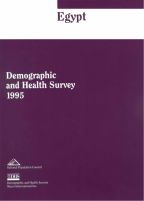Gender in the Demographic & Health Surveys: Past, Present, & Future
This post is part of a series commemorating 30 years of The DHS Program.
When I first started at The DHS Program in late 1993 as a Women-in-Development Specialist, the survey questionnaires contained few questions that could shed light on the impact of gender on demographic behavior and health. While the questionnaires were designed to collect all kinds of information on women’s and children’s health, women’s use of contraception, fertility, mortality and nutrition, there was virtually no information on the status of the women themselves other than information on their education and employment. In other words, there was little information that provided insights into the gendered context within which the health and demographic behavior of women and households was being determined.

1995 Egypt DHS
So I had a lot of work to do. My challenge was to develop a parsimonious module of questions that in the future could potentially be used by DHS surveys across the world to better understand the role that gender plays in demographic and health outcomes. To this end I put together a set of questions on women’s status based on a thorough literature review and an examination of several studies that used questionnaires to measure women’s status and gender relations in the household. Once ready we managed to include this module of questions in the 1995 Egypt DHS. Preparing the module was challenging since the literature provided mostly proxy indicators of women’s status at the household level, but few that could directly measure empowerment. Additionally, since one of the key features of The DHS Program is that it provides comparable data across countries, I needed questions that had similar meaning across cultures with widely varying perceptions of women’s roles. The pilot of the Women’s Status Module in the Egypt DHS yielded a lot of useful information and helped determine the key indicators that would be useful to have for most countries such as the questions on women’s role in household decision making, their attitudes towards spousal violence, and barriers to accessing health care for themselves.

1998 Nicaragua DHS
Another gender-related topic that really increased in importance during my tenure as the Senior Gender Advisor to The DHS Program is domestic violence. The women’s status module implemented in Egypt contained only a couple of questions on women’s experience of domestic violence and the 1990 and the 1995 Colombia DHS surveys included country-specific questions on domestic violence. Then in 1998, a module of questions that utilized a modified conflict tactics scale approach (Strauss 1990) to the measurement of violence was implemented in the Nicaragua DHS. It was this module that became the foundation for the core DHS Domestic Violence Module which was finalized and piloted around 2000. Overtime we also developed a protocol for the ethical collection of data on violence, particularly for the protection of female respondents and field interviewers. However, having a standardized module and protocols for its implementation, did not mean that countries were immediately interested in collecting information on domestic violence. There was first a need to try and overcome commonly held beliefs that domestic violence was not a State concern and had no place in a demographic and health survey. Additionally few believed that women would be willing to talk about their experiences of violence.
The 1995 Egypt DHS marked a new chapter in the life of The DHS Program. Questions on women’s empowerment are now part of the core questionnaire and asked in most countries. The Domestic Violence Module has been included in more than 95 surveys in over 50 countries. Survey data have been used for major legislation, advocacy efforts, and national programs to protect women in their own homes in countries as diverse as Moldova, Uganda, Timor Leste, and Zimbabwe. Analysis of DHS data has convincingly linked violence with negative reproductive health outcomes and HIV, showing that violence is an important public health issue as well as a violation of individual rights.
In the coming years, The DHS Program will continue to collect more information on women’s empowerment. The 2014 revised survey instruments now include questions on women’s ownership of mobile phones, personal bank accounts, and ownership and co-ownership of property. We have come a long way since the first pilot module on women’s status, and we will continue to be on the forefront of research into women’s lives.
Reference
Straus, M.A. 1990. Measuring intrafamily conflict and violence: the conflict tactic (CT) scales. In M.A. Straus and R.J. Gelles (eds.) Physical Violence in American families: Risk Factors and Adaptations to Violence in 8,145 Families. 29-47. New Brunswick: Transaction Publishers.



Thank you, Dr. Kishor, for your vision and persistence in including gender questions to enable measuring women’s empowerment.